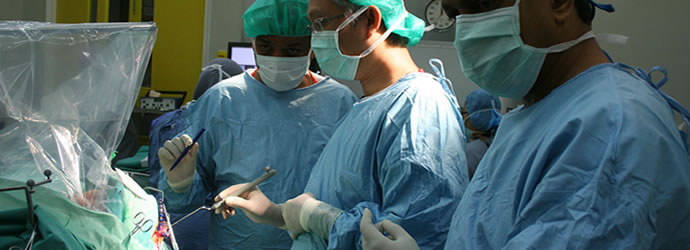By Shahfizal Musa
Pix UKMMC
KUALA LUMPUR, 12 March - The National University of Malaysia (UKM) achieved yet another milestone when a patient was made to wake up during a brain surgery last February.
It was UKM Medical Centre first Awake Craniotomy, a
procedure to remove brain tumor with minimal or no brain damage to the patient.
Some might think that waking up during surgery is a terrifying experience but in this case it was intentional. The patient needed to be conscious to
monitor and preserve his brain functions. The procedure was performed by UKM Neurosurgeon, Associate
Prof Dr Ramesh Kumar assisted by three other surgeons, Dr Toh Charng
Jeng, Dr Sanmugarajah Paramasvaran and Dr Ainul Jaffar.
Dr Esa Kamuruzaman was the anesthetist responsible in
sedating the patient before his skull was opened up and for bringing the him to consciousness during the surgery, just before the tumor is cut out.
The complex surgery is commonly done to remove tumors that
grow in the eloquent brain. These are areas of the brain that allow us to
communicate, perceive, interact and have movement. They regulate our senses,
movement and speech, a very important part of living a normal life.
What is fascinating about the unique procedure is the
patient participated in his surgery by giving feedback to the surgeon, who in
turn will react accordingly. It is quite a scene when the patient woke up
during the operation and starts responding to questions. He also gave a priceless grin when he was asked to smile.
When asked why a patient need to be awake during the
surgery, Dr Ramesh explained: “This technique was developed to allow maximum
excision of the lesion while causing minimum or no injury to the surrounding
normal brain tissue so that the patient has minimal or no functional loss.
“The best way to know that the patient has his functions
intact is from his response. You cannot know this when the patient is
unconscious”.
Dr Ramesh said the patient will be asked to perform simple
task related to the critical area, while the tumor is removed. Any changes in
function are monitored and the surgeon stops further dissections in the related
area if any adverse effect is detected.
Though current scanning technology like MRI can pin point
where the tumor is but it is not accurate enough.
“By resorting only to the MRI scan, the surgery will be very
much like walking in a mine field. Any damage to eloquent areas even by a
millimeter can mean living with a disability for the rest of the patient’s
life. It might harm the ability to speak or move or even think.
“Although functional MRI can show the motor and speech
areas, it may not accurately pin point the most important areas and therefore
the brain mapping done with direct electrical stimulation on the brain while
the patient is awake remains as the most reliable avenue for neurological
preservation,” Dr Ramesh said, the patient is given general anesthesia before commencing
surgery to render him unconscious. Then the surgeon will get to work and start
drilling his skull to gain access to the patient’s brain.
The sedation is given initialy because the
scalp and pericranium (tissue overlying the bone) is pain sensitive while the
brain is not.
“Once the skull is opened the anesthesia is reversed and the
patient is awakened. Upon completion of the excision of the lesion, the
patient is put to sleep again and the skull opening is then closed”.
It is no secret that Awake Craniotomy is a very scary option
to the patient so before the patient undergo the procedure he is counselled and
guided every step of the way.
The patient is now recovering splendidly. He is fit enough to give a press conference to the media.
No comments:
Post a Comment